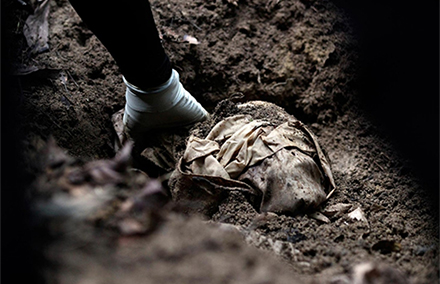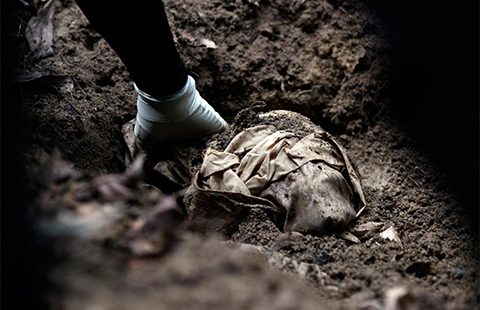
Remains found in a mass grave at a human trafficking camp in Malaysia. Photo by Al Jazeera.
Turning a blind eye to the links between corruption and human trafficking is costing lives.
In Malaysia, corruption kills. Recent casualties include the victims of the human trafficking trade conducted across the border with Thailand.
In May this year, Thai authorities discovered human trafficking death camps in the jungles of southern Thailand. Reports were rife that similar death camps existed on the Malaysian side of the border.
The Home Ministry on 10 May dismissed these reports saying their investigations had found no such camps nor graves.
But, two courageous journalists from Malay Mail, S Arulldas and Sayuti Zainuddin, risked life and limb to search out the death camps and proved the Ministry wrong. After covering difficult terrain, they arrived at a clearing where they were shocked to see 40 mounds of soil with freshly dug graves. They also found a deserted camp that could have housed over 1,000 people.
On 16 May, the Malay Mail broke the story. Malaysians woke up to the disturbing news that these gruesome murders had taken place on our soil. Malaysian police subsequently confirmed that they had indeed discovered the death camps in a village known as Wang Kelian. On 25 May the Ministry announced that they had found 30 mass graves containing 100 corpses. The Inspector General of Police (IGP) confirmed that a total of 139 graves and 28 trafficking camps had been found.
Both the Home Minister and the IGP expressed shock at the discovery of the graves and denied knowledge of their existence, although they admitted that the camps must have been there for a while.
Villagers living close to the camps, however, were not shocked at all. They claimed that for years they had seen emaciated, abused and starving migrants emerging from the jungle from where the camps were found. The villagers gave them food, handed them over to the police, and they were never seen again.
The Malay Mail had also reported that villagers spoke of syndicates bringing victims in vans after midnight in what was clearly a well-established trafficking operation.
Tenaganita, an NGO experienced in helping trafficking victims, claimed that the police have known about the north Malaysian trafficking trail and the existence of the camps for years.
The fact is, local and international human rights groups have been warning Malaysia of the extensive human trafficking trade that operated with the connivance of officials. In 2009, the US Senate Committee on Foreign Relations highlighted the dire situation of trafficking in Malaysia. The report included anecdotal evidence that revealed a massive trafficking operation involving Malaysian officials.
In 2010, the Equal Rights Trust published the report, Trapped in a Cycle of Flight: Stateless Rohingya in Malaysia. It found that there were high levels of corruption at Malaysian detention centres and that deals relating to trafficking activities at the Thai border were sometimes initiated there. These deals were allegedly put together by immigration officials.
In fact, Myanmar migrants were often transported to the Malaysia-Thai border in official immigration department vehicles and handed over by immigration officials to Thai human traffickers. The traffickers then facilitated contact with relatives of the migrants in Malaysia and ransoms were demanded. If a ransom was not forthcoming, the victim was often tortured and abused and eventually sold into forced labor.
In 2014, the US Trafficking in Persons (TIP) report criticised Malaysia’s enforcement efforts and again highlighted accounts of the involvement of officials in facilitating trafficking. It found that the Malaysian government did not fully comply with the minimum standards for the elimination of trafficking. Consequently, Malaysia was relegated to a Tier 3 status; the lowest ranking reserved for countries whose governments do not fully comply with the minimum standards and are not making significant efforts to do so.
Despite being made fully aware of the extent of the problem for over five years, the government had simply “looked the other way”.
True to form, this May, the government expressed concern about the mass graves and assured the public that they will find those responsible. Unfortunately, going by past experience, these words are unlikely to mean much.
The authorities started by promising a thorough investigation when the graves were first discovered. Yet the information released became more and more sketchy each day, and was sometimes contradictory. Over two months later there is lack of clarity as to what has occurred. All we know is that 99 bodies have been found. This was despite the initial report that there may be as many as three to four bodies in one grave.
Trafficking in persons on this scale is a trade that cannot flourish without the involvement of officials and agencies whose task it is to police such criminal activities.
Studies by Transparency International and the UNODC in 2011 found that trafficking relies on pay-offs to public officials at all levels and cannot flourish otherwise. In fact Transparency International laments that not enough attention is given to the connection between corruption and human trafficking. They make the point that:
Corruption both facilitates trafficking and feeds the flow of people by destabilising democracies, weakening a country’s rule of law and stalling a nation’s development.
On 3 June, Malaysia’s mainstream press carried a report based on 10 years of surveillance by the Special Branch, a unit of the Royal Malaysian Police which collects security intelligence. They found that 80 per cent of Malaysian law enforcement officers at the country’s borders were engaged in corruption with some apparently being directly on the smuggling syndicate’s payroll.
These included syndicates who were also involved in the smuggling of drugs and weapons. Although the Special Branch has shared this intelligence with the relevant agencies, there appears to be no follow through. When asked about the report, the Minister of Home Affairs was reported to have said that such institutionalised corruption must be arrested once and for all.
Malaysians have heard such statements before. They emanate from the leadership that on paper acts as if it is serious about corruption. The reality is quite the opposite.
The Malaysian Anti-Corruption Commission seems keen to do its part, but its efforts are often stymied by a reluctance to prosecute in the Attorney General’s office. They also seem helpless to proceed in appropriate cases against powerful political figures. Some action has been taken against a few officials involved in the immigration detention centres, but the question still remains why this could not have been done sooner and on a broader scale. Are they merely going after those on the lower rungs while those higher up get away?
A survey carried out by Ernst & Young in 2013, showed that Malaysia was one of the most corrupt countries in Asia. This was despite the claim by the government that measures to combat corruption were in place.
And therein lies the problem. On paper it may seem that there are mechanisms in place to fight trafficking and corruption. The reality is that there is a total lack of political will to do so. Corruption in Malaysia is endemic. It pervades every aspect of our lives like a cancer. It results in, and is a part of, the larger problem of poor governance, a lack of transparency and a lack of political accountability.
In criticising Malaysia on its trafficking record, there must be criticism of our system of governance. The issue of the mass graves goes to the very soul of our nation. Our authorities and institutions have to be jolted into the realisation that they have allowed Malaysia to sink to a level that allows murders of innocent victims to take place with impunity.
In the 2012 and 2013 US Trafficking in Persons reports, Malaysia was granted consecutive waivers from a downgrade to Tier 3. These were given on the basis of a written plan to bring itself into compliance with the minimum standards for the elimination of trafficking. The Trafficking Victims Protection Authorization Act (TVPA) authorizes a maximum of two consecutive waivers. In 2014 it was automatically downgraded to the lowest level of Tier 3.
Given the horrors reported this year, it comes as a shock to learn that despite the positions taken by TIP in the past, there may be a possibility that Malaysia may now be upgraded to Tier 2. The explanation appears to be that the discovery of the mass graves came after the relevant period under consideration.
This is an unacceptable stand. There is no credible evidence that shows that the relationship between human trafficking and corruption has been addressed, nor are there markers to show improvement in protections or enforcement. In fact, the reality is quite the opposite.
If the guidelines of the TIP are followed, Malaysia can only be moved from Tier 3 to Tier 2 if they have shown credible efforts in the period under review to fight human trafficking. What could those efforts be which resulted in so many deaths?
If the Obama administration raises Malaysia’s status to Tier 2, they will lose credibility. Worse it would seem that the US, who claims to value human rights, is prepared to barter ours away for their own benefit.
Dato’ Ambiga Sreenevasan is President of the Human Rights Society of Malaysia (HAKAM). She was the President of the Malaysian Bar and Co-Chairperson of Bersih 2.0, a movement for free and fair elections.
 Facebook
Facebook  Twitter
Twitter  Soundcloud
Soundcloud  Youtube
Youtube  Rss
Rss 